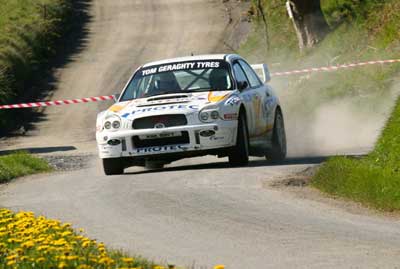History of rallying
Continued from the homepage...
Rallying is among the oldest branches of motorsport, with a history stretching back over a century. There's a case for saying that it all began back in 1894, with the Paris-Rouen Horseless Carriage Competition, but the term itself dates from 1911. That year saw the first running of one of rallying's classic events: the Monte Carlo Rally. That continues to this day, albeit in a rather truncated form given the demands of today's TV-fixated audience. During the 102 years it has been around, though, it has seen rallying change almost out of all recognition.
Almost as soon as rallying had established itself, it was stopped in its tracks by the outbreak of the First World War; things didn't really get going again until the mid-1920s. At this point, the sport was centred on the Alpine countries, with events such as the Alpenfahrt and the Coppa delle Alpi attracting entrants from all over Europe. British teams were particularly well represented, with the likes of MG and Riley seeing rallying as an opportunity to demonstrate the speed and strength of their cars. By the mid-1930s, works teams from Nazi Germany were also becoming more prominent.
The Second World War again brought a halt to the sport, but the immediate post-war period saw rallying truly establish itself as a major branch of motorsport. Many classic rallies, like Finland's 1000 Lakes and Greece's Acropolis, came into being in this era, while British works outfits coming back to prominence. Pat Moss, the younger sister of Formula One driver Stirling, was among the stars of the period, winning the 1960 Liège-Rome-Liège Rally outright in the Austin-Healey 3000. In 1962, she scored the first ever win for a Mini on the Tulip Rally, paving the way for Paddy Hopkirk's Monte Carlo Rally heroics later in the 1960s.
Rallying was by now expanding outside its European heartland: in the Americas, the Carrera Panamericana achieved fame - and notoriety - despite lasting for only a few years. In 1953, a rather more durable rally was born in Africa: the Safari. Even so, a true World Championship for rallying would have to wait until 1973. By that time, northern European drivers - especially the "flying Finns" - had become a force in the sport, thanks in part to the development of the special stage in Scandinavia during the 1950s and 1960s. As with circuit racing, this period also saw a shift from a wholly amateur sport to one in which the top drivers were paid professionals.
With global exposure growing rapidly, manufacturer interest grew, with Audi's four-wheel-drive Quattro dramatically raising the stakes in 1980. The push for ever faster and more powerful cars culminated in the "Group B monsters" of the mid-1980s; they were banned in 1986 after a series of tragic accidents. Things remained relatively stable in the remaining Group A class for some years, though southern Europeans like Francois Delecour and, especially, Carlos Sainz came to challenge the Scandinavians for honours. Britain's late, great heroes of the modern age of rallying, Colin McRae and Richard Burns, also learned their trade in the Group A era.
This was to prove something of a high water mark for rallying, and the sport has struggled for attention in recent years, sometimes not seeming certain of its direction. Works support has been variable, with manufacturers rarely committing to the World Rally Championship for more than a few years due to low brand exposure due to low-priority TV coverage, and the high costs of the logistical operation (although aided these days somewhat with the addition of fleet telematics as explained here).
Indeed, the WRC's very existence has more than once been in question. The dominant driver of the modern era is undoubtedly France's Sebastian Loeb, although his nine consecutive titles may say more about the fractured nature of rallying in the 21st century than it does about Loeb's undoubted talent.




